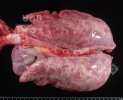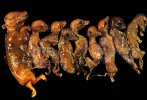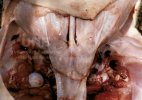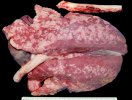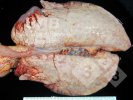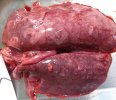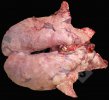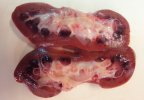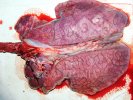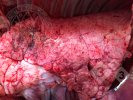PRRS
The Porcine Reproductive and Respiratory Syndrome (PRRS) is the viral infection with the highest economical impact in North America and many European countries. The virus causes reproductive problems and affects the respiratory system.
Alternative names: Porcine respiratory and reproductive syndrome, Blue ear disease
Information
The Porcine Reproductive and Respiratory Syndrome (PRRS) is caused by an arterivirus. The virus is classified in two types: North American and European (or Lelystad). The virus is very susceptible to the environment and disinfectants, and is characterized by its great capacity to mutate. The virus has a special affinity for alveolar macrophages found in the lung. Macrophages are part of the immune system ingesting and eliminating invading bacteria and viruses. The virus multiplies inside the macrophages producing more virus, and the cells die in the process. It destroys up to a 40% of macrophages, which eliminates most of the animal’s defense mechanisms and allows bacteria and other virus to proliferate and damage the respiratory system. The virus can cross the placenta and infect fetuses from 70 days of pregnancy, causing abortios in the third trimester and mummies or stillborn.
Once the virus has entered a farm, it stays in it and keeps active.
After an initial introduction of the virus, the infection of all breeding animals may take up to a year, especially in big farms. Although the virus appears to disseminate rapidly, positive seroconversion of at least 90% of the sows can take 4 to 5 months. Adult animals excrete the virus for shorter periods (14 days) than growing pigs, which excrete the virus during an average of 1 to 2 months (more than 5 months in some animals).
The clinical situation can vary a great deal from one farm to another due to the huge amount of different strains. Despite of the virus sequencing, it is impossible to predict the virulence, clinical presentation or crossed protection between each identified strain. Recent research has identified some swine genetics that are more resistant to the virus. Many modern farms based on their biosecurity system as their best PRRS prevention tool. The virus can be transmitted in semen.
Its chronic presentation is very variable. Clinical conditions are usually similar to the ones seen in the acute presentation, but it only affects a percentage of animals, especially gilts. The chronic form affects animals of all ages but with less severity.
Symptoms
Symptoms are very variable depending on the strain. North American strains are clinically more severe.
Acute disease
Sows
- Short periods of inappetence.
- Fever.
- Abortion, especially at the end of pregnancy (third trimester). These are often the first notticeable signs.
- A transitory blueing color in the ears (blue ear disease) may be observed.
- Some sows farrow earlier.
- Increase in returns 21 to 35 days post service.
- Longer anoestrus and delayed returns to estrus post weaning.
- Coughing and respiratory signs.
- Agalactia and mastitis.
- Farrowings occur 2 to 3 days early.
- Mummified piglets.
- Stillborn levels increase.
- Weak piglets at birth.
Lactating piglets
- Diarrhea.
- Less viable piglets.
- Increase of respiratory infections like Glässer and Streptococcus suis.
Boars
- Loss of appetite.
- Increase of body temperature.
- Letargy
- Loss of libido.
- Lowered fertility.
- Small litters.
- Lowered semen production.
Nursery and fattening
- Slight inapetence period.
- Increase of infectious disease that were under control (Salmonella, enzootic pneumonia, App, PCVAD, Streptococcus suis).
- Moderate coughing.
- Susceptible to respiratory infections (Mycolasma, influenza), resulting in acute pneumonia with extensive consolidation.
- Sneezing.
- Some farms do not show symptoms.
- Loss of daily weight gain.
- Increase of mortality.
Chronic disease
Sows
- Abortion is present but at a lower rate (2-5%).
- Few sows with transient bluish coloration.
- Some sows give birth prematurely.
- Increased returns at 21-35 days after mating.
- Prolonged anestrus and late returns after weaning.
- Agalactia and mastitis.
- Mummified piglets.
- Levels of stillbirths remain high.
- Some weak piglets at birth.
Piglets
- Less viable piglets.
- Increased respiratory infections such as Glässer and Streptococcus suis.
Boars
- Loss of libido.
- Decreased fertility.
- Small litters.
Nursery and fattening
- Increase of infectious diseases that were once under control (Salmonella, enzootic pneumonia, App, PCVAD, Streptococcus suis).
- Moderate cough.
- Susceptible of having respiratory infections (Mycoplasma, flu), results in acute pneumonia with extensive consolidation.
- Sneezing.
- On some farms no symptoms.
- Loss of daily gain.
- Increased mortality.
Causes / Contributing Factors
Common methods of spread:
- Movement of carrier pigs.
- Airborne transmission.
- Mechanic transmission specially with needles.
- Contaminated boots and clothing.
- Transport vehicles especially in cold weathers.
- Transmitted via semen.
- PRRS affects all kind of farms, including high or low health status farms, extensive or intensive production systems; any size.
- Nasal secretions, saliva, feces and urine.
Diagnosis
This is based on the clinical signs, post mortem examinations and the known presence of the virus by PCR. There are several tests available, but ELISA is the standard test used. Currently, oral fluids are used to monitor farms. Virus sequencing can only be used epidemiologically to investigate the presence of a new strain and possibly its origin.
Control/Prevention
- There is not any treatment available against the virus. Biosecurity still is critical to prevent virus introduction.
- Replacement animals must originate from PRRS negative farms.
- All the semen used must be obtained from insemination centers that have PRRSV negative boars and that monitor their animals.
- The reproduction objective is to stabilize the sows and maybe eradicate the virus through replacement animal management.
- When an initial outbreak appears in a reproductive unit, it can be depopulated, cleaned, disinfected and repopulated with PRRS negative animals. If this is not possible due to high costs, the following steps must be performed:
- Introduce replacement gilts of different ages.
- Homogenize the unit exposing all pigs and sows of all ages to the field virus or to a live modified vaccine.
- Close the farm for a minimum of 200 days.
- All piglets born must leave the unit when weaned. This means the unit cannot keep any piglet to finish it in the same unit. The reason is to avoid the existence of susceptible animals that may disseminate the virus.
- Growing and finishing pigs’ management should include special care and the supply of an adequate environment during the acute phase. Antibiotics can be strategically used to prevent/control secondary bacterial infections.
- Vaccine use is common in breeding and finishing units.
- Killed vaccines are not effective, thus live modified vaccines are recommended.
- The use of air filters is also recommended, especially in boars units.

